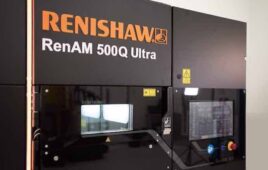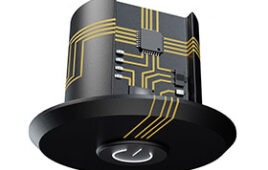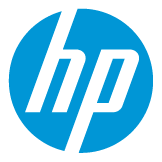
10% of all employees’ time is spent “harvesting” the 3D printers, unloading and loading the print plates.
The robot arm gently places a plate with an orange Pokémon figure on a conveyor, picks up a new blank plate from a hopper, places it back in the 3D printer, and queues the system to start a new build. Toys are serious business here at Voodoo Manufacturing, a Brooklyn-based startup that has created a niche for itself producing plastic parts in runs of fewer than 10,000 items using an army of 160 3D printers. Products ranging from prosthetic hands to protective dog eyewear are now produced in this setup, called “Project Skywalker,” that the company believes is the first-ever robot-operated cluster of 3D printers.
The UR10 collaborative robot is helping Voodoo Manufacturing take 3D printing from a technology mostly used for producing prototypes and high-value components to become a viable alternative to the mass production of plastic parts done through injection molding, a more cost-intensive production process.
“When we were looking for a robotic arm, we were looking for one that could do the tasks, but would also be easily programmable and get up and running very quickly. For us, Universal Robots’ UR10 was a great option,” said Jonathan Schwartz, Chief Product Officer of Voodoo, adding that the collaborative safety features were imperative.
The robots are classified as “collaborative” due to their built-in safety system that makes the arm stop operating if it encounters objects or people within its route. This feature enables humans and robots to literally work side-by-side—with no fencing as is generally required with traditional industrial robots.
“So instead of building a factory with caged-off areas and potential hazards, we are now able to create a friendly workplace with continuous and spontaneous improvement and interaction between humans and robots,” said Schwartz.
Voodoo Manufacturing estimates that the cost of implementing a UR robot was about five times less expensive than a traditional industrial robot, due to the quick integration that did not involve safety cages, light curtains, and other safety measures usually needed when robots are at work in a factory setting.
Fast integration
Getting a proof of concept for Project Skywalker was a race against time as Voodoo Manufacturing was pitching investors.
“We didn’t have a couple of years to put something through R&D, we needed it here and now. We got the UR10 out of the box and were able to get it running within just a few hours,” said Schwartz, who also needed a gripper that could be seamlessly integrated at the end of the robot arm. “One important aspect for choosing the UR10 was that there were really good peripherals that we could use with it,” said Schwartz, who chose a two-fingered gripper from Robotiq.

Voodoo chose the UR10 robot arm, as it interfaced seamlessly with the Robotiq gripper through the UR+ platform. The Brooklyn startup 3D printed their own extensions to the gripper, enabling it to grab the build plates.
The gripper is part of the rapidly expanding Universal Robots+ platform that features plug-and-play products for the company’s robots. Cynthia Kradjel, Account Manager with Universal Robots distributor Axis New Jersey, recommended the Robotiq gripper as she knew its UR+ certification meant hassle-free integration. “A UR+ product is tested and proven, the gripper software has even been integrated right on the robot’s own touch screen, which eliminated countless hours of trial and error, scripting code,” she said.
Charlie Fenwick, industrial engineer at Voodoo, emphasized how the integration ended up being the deciding factor in choosing the right robot solution. “We looked at different robot arms, but none of them had the ability to easily interface with the peripherals required to get the complete application up and running,” he said. “Getting the gripper to work with the arm was almost like building a Power Point slide, by just dragging blocks of information onto the screen. All you have to do is link up the different blocks and it basically runs itself,” said Fenwick, adding that his team unexpectedly finished the project ahead of schedule.
Harvesting—the low hanging fruit
The UR10’s work assignment of loading and unloading plates is called “harvesting,” which took up to 10% of all labor hours. This low-value-added activity is what Schwartz describes as “a perfect and almost quantifiable task” that he felt confident in being able to automate with speed, accuracy, and precision.
Voodoo has 160 3D printers. By placing the UR10 on a mobile base roaming the 18,000 square feet factory, the company will be able to use the collaborative robot to tend 100 printers. By adding another UR10 to its fleet, Schwartz will take the startup from 30–40% printer usage up to 90%. “And from here on out as we scale, we can just buy more arms as we have more and more printers,” said Schwartz, who is not hesitant to call Project Skywalker “a massive success,” adding that “even though we shouldn’t have been surprised by the results, we all had this strong realization of how much of a game-changer this would be.”
The key to tripling output is the fact that the robot can run overnight. “We can monitor the robot through our own software and access the status of any given printer to see whether it’s printing or idle, which means we can deploy this in our factory and run it 24/7 without any human oversight,” said Schwartz, who describes it as “magical” first morning he came in to find more than 30 completed print runs handled by the robot overnight.

The UR10 is the largest of Universal Robots three models, with a span of 51 in. and a payload of 22 lbs.
Voodoo’s three-year goal is to reduce cost by 90%. The increased output compared with the reduction in labor cost provided by the company’s first UR10 means that the robot will pay itself back in less than six months. “If we’re going to increase our output ten-fold over the next couple of years, we have to do that without increasing our costs by 10x and the robots will be instrumental in achieving this,” said Schwartz, emphasizing that automating the harvesting was just the first step. “Beyond this, there are many other opportunities in our factory to automate; whether it is removing parts from the build plates, or cleaning them, or inspecting them for quality, or eventually even packing and shipping.”
Right now, Voodoo can compete with low-volume injection molded parts, but if the company is to compete at higher volumes such as batches of 100,000, they need to continue executing their automation strategy. In the long term, Schwartz envisions Voodoo scaling up its operation to around 10,000 3D printers. These printers will be able to use new materials and make products that you can’t see are 3D-printed. For the Brooklyn startup, automation is more than simply a way of cutting costs. “It’s the only way we’ll survive to be a large company that employs hundreds, if not thousands, of people,” said Schwartz. “In taking on such massive and deeply entrenched industry such as injection molding, automation is going to be our primary weapon.”
This weapon is not one that will kill jobs, Schwartz feels.
“The UR robots free our employees from a lot of the tedious tasks that we currently do in our factory and move them into higher-value positions that require more critical thinking,” said Schwartz. “Over the past 30 years, manufacturing has left the United States mainly because of the very cheap labor costs overseas; but we feel that is changing with new technology such as this robotic arm. Now we can build a factory that can actually compete on cost with Chinese factories. In the next ten years, we’re going to see manufacturing come back to the United States, and I predict an increase in manufacturing jobs available right here.”
Universal Robots
www.universal-robots.com
Voodoo Manufacturing
www.voodoomfg.com
Filed Under: 3D printing • additive • stereolithography, The Robot Report





Tell Us What You Think!